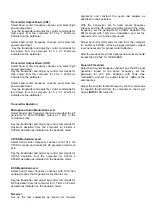
Because of the bridge audio amplifier circuit used in the
radio, it is necessary to construct and use a simple audio
load test adapter as shown in the schematic diagram
above, when conducting receiver alignment steps.
3.5mm PLUG
Attenuated
Test Output(1/2)
2ohms 10W
Ground
+ 470uF
2ohms 10W
AF Test Adapter Schematic
Alignment Channel Frequencies
VHF TYPE A
Channel
Frequency
(simplex)
CTCSS
Encode
DCS
Encode
Narrow
/wide
CH1
134.01MHz
None
None
Wide
CH2
147.01MHz
None
None
Wide
CH3
159.99MHz
None
None
Wide
CH4
134.01MHz
None
None
Narrow
CH5
147.01MHz
None
None
Narrow
CH6
159.99MHz
None
None
Narrow
CH7
147.01MHz
151.4Hz
None
Wide
CH8
147.01MHz
None
023
Wide
CH9
147.01MHz
151.4Hz
None
Narrow
CH10
147.01MHz
None
023
Narrow
VHF TYPE C
Channel
Frequency
(simplex)
CTCSS
Encode
DCS
Encode
Narrow
/wide
CH1
148.01MHz
None
None
Wide
CH2
161.01MHz
None
None
Wide
CH3
173.99MHz
None
None
Wide
CH4
148.01MHz
None
None
Narrow
CH5
161.01MHz
None
None
Narrow
CH6
173.99MHz
None
None
Narrow
CH7
161.01MHz
151.4Hz
None
Wide
CH8
161.01MHz
None
023
Wide
CH9
161.01MHz
151.4Hz
None
Narrow
CH10
161.01MHz
None
023
Narrow
UHF TYPE A
Channel
Frequency
(simplex)
CTCSS
Encode
DCS
Encode
Narrow
/wide
CH1
400.01MHz
None
None
Wide
CH2
415.01MHz
None
None
Wide
CH3
429.99MHz
None
None
Wide
CH4
400.01MHz
None
None
Narrow
CH5
415.01MHz
None
None
Narrow
CH6
429.99MHz
None
None
Narrow
CH7
415.01MHz
151.4Hz
None
Wide
CH8
415.01MHz
None
023
Wide
CH9
415.01MHz
151.4Hz
None
Narrow
CH10
415.01MHz
None
023
Narrow
UHF TYPE D
Channel
Frequency
(simplex)
CTCSS
Encode
DCS
Encode
Narrow
/wide
CH1
450.01MHz
None
None
Wide
CH2
465.01MHz
None
None
Wide
CH3
479.99MHz
None
None
Wide
CH4
450.01MHz
None
None
Narrow
CH5
465.01MHz
None
None
Narrow
CH6
479.99MHz
None
None
Narrow
CH7
465.01MHz
151.4Hz
None
Wide
CH8
465.01MHz
None
023
Wide
CH9
465.01MHz
151.4Hz
None
Narrow
CH10
465.01MHz
None
023
Narrow
UHF TYPE F
Channel
Frequency
(simplex)
CTCSS
Encode
DCS
Encode
Narrow
/wide
CH1
480.01MHz
None
None
Wide
CH2
496.01MHz
None
None
Wide
CH3
511.99MHz
None
None
Wide
CH4
480.01MHz
None
None
Narrow
CH5
496.01MHz
None
None
Narrow
CH6
511.99MHz
None
None
Narrow
CH7
496.01MHz
151.4Hz
None
Wide
CH8
496.01MHz
None
023
Wide
CH9
496.01MHz
151.4Hz
None
Narrow
CH10
496.01MHz
None
023
Narrow
PLL & Transmitter
Set up the test equipment as shown for transmitter
alignment.
Maintain the supply voltage at 13.8V DC for all steps.
PLL VCV
Connect the positive lead of the DC voltmeter to the test
point TP1013 (VCV) on the Main Unit, as indicated in the
figure, and the negative lead to chassis ground.
Set the transceiver to the high band edge frequency
channel, then adjust coil on the Unit for 4.2 V on the
voltmeter.
VHF: L1016 / UHF: L1021
Key the transmitter, and adjust coil on the Unit for 4.2 V
on the voltmeter.
VHF: L1017 / UHF: L1022
Next select to the low edge frequency channel and
confirm about 1.0 V (0.8V – 1.2V) on the voltmeter.
Key the transmitter, and confirm about 1.0 V(0.8V – 1.2V)
on the voltmeter.
PLL Reference Frequency
With the wattmeter, dummy load and frequency counter
connected to the antenna jack, and select band center
frequency channel, key the transmitter and adjust
TC1001 on the Main Unit, if necessary, so the counter
frequency is within 100 Hz of the channel center
frequency for the transceiver version.





















